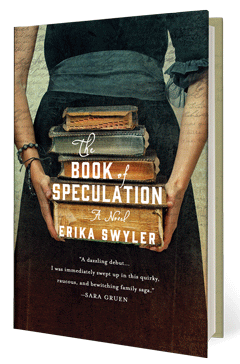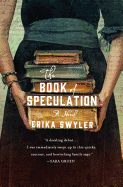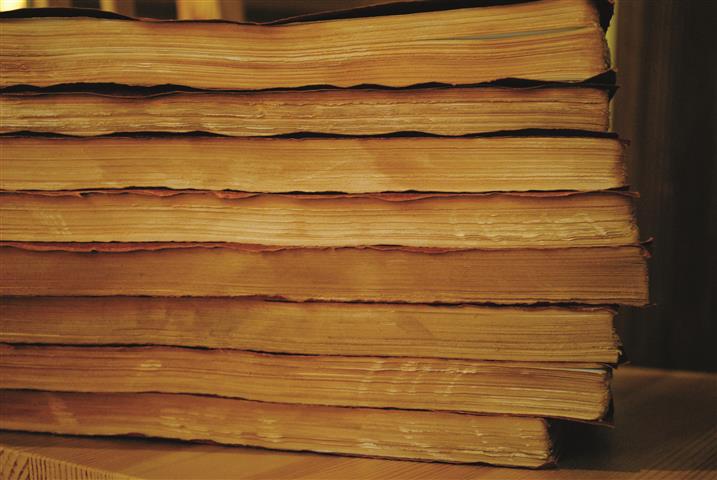The Book of Speculation
by Erika Swyler
Erika Swyler's debut novel, The Book of Speculation, opens on a precipice: Simon Watson's house teeters, ready to tumble into the sea. "The Long Island Sound is peppered with the remains of homes and lifetimes, all ground to sand in its greedy maw. It is a hunger."
Simon is precariously employed as a librarian, and thus lacks the funds to shore up his family home, from which his family is gone: his mother drowned, his father dead from grief, and his sister, Enola, departed, making her life with a traveling carnival. These days, Simon's community is composed largely of the next-door neighbor, Frank, a longtime friend of Simon's parents; and Frank's daughter, Alice, a library colleague and a reliable constant in Simon's life.
Enola rarely visits, but happens to be on her way home just when Simon receives a strangely apt package in the mail: an antiquarian book dealer, a stranger, has sent him a very old book which he believes has ties to Simon's family history. The bookseller, Martin Churchwarry, bought it as part of a lot at auction, purely on speculation. It is the log book of Peabody's Portable Magic and Miracles, a traveling circus in the 1790s, and contains the name of Simon's grandmother. A librarian with archival experience, Simon is ready to treasure this unexpected gift on several levels, but puzzled by the family connection. Still, it draws him in, and by the time Enola arrives, he is thoroughly absorbed. She is unimpressed with his studies, while her obsession with her own tarot cards seems to be growing.
Simon reads and researches the names he encounters in Peabody's book, calling into service his librarian friends and Martin Churchwarry himself, with whom a strangely easy friendship is established. These efforts yield a disturbing pattern. Simon already knew his mother was a "mermaid": she could hold her breath for many minutes at a time, a trick she taught to her children. This skill notwithstanding, she drowned herself on a 24th of July. Simon did not know, however, that she came from a line of circus-performing mermaids, all drawn to the water, and that they all died by drowning on the 24th of July. In mid-July, as Enola, acting strangely, returns to their home by the sea, Simon fears that time is running out if he hopes to solve this puzzle and save his sister.
Meanwhile, the events of the past simultaneously engage the reader, as chapters alternate between Simon's time and that of Peabody's menagerie. A mystical Russian tarot card reader, an avuncular business-minded circus boss and other colorful characters populate the parallel thread of The Book of Speculation. But in Peabody's world, it is Amos, a mute bastard who plays the "Wild Boy," who will most capture the reader's imagination and compassion.
The strengths of Swyler's novel are many. The atmosphere of storm-tossed Long Island, with a house that threatens to dive into the sea, is at once fully, realistically wrought and fanciful: Is there a curse? Simon pursues the secrets of his family as his life literally falls apart around him, floor, ceiling, foundation and memories crumbling. Likewise, Peabody's peripatetic enterprise evokes the promised "magic and miracles," as well as more prosaic hazards. Each chapter is in itself a small departure into a fantastic, engrossing world. Imagery of woods and animals, small towns and family dynamics are finely drawn; everywhere is the water that frames both stories, from the Long Island Sound that menaces Simon's home and those he loves to the rivers and streams alongside which Peabody travels. Indeed, if this story has a soundtrack, it is the gurgling waters that promise both succor (and ruin) to the mermaids' line.
The Book of Speculation is driven both by character and by plot, as the reader aches for the vulnerable Wild Boy in Peabody's circus and roots for the crooked romances of Simon's time, and wonders, as the story develops, whom to trust. To round out an eccentric cast, Enola brings home a boyfriend from the circus who is covered in tattoos and possesses an electrifying special talent, and Simon explores new ground with Alice, the girl next door. Each of the men and women from both timelines proves multi-faceted and compelling. The overall effect is captivating, as Swyler's delightful, mesmerizing prose keeps the story tripping playfully along through both light and dark moments. As Simon pursues the loose ends and they tie oddly together, Swyler keeps the pressure and the pacing on, as her characters struggle to make connections.
The meandering plot offers many charms: likable, quirky librarians; circus menageries and freak shows; love stories; tarot cards and trickery; mysticism; family secrets; and prickly sibling love--all accompanied by the author's illustrations. [Swyler also painstakingly hand-bound, gilded and aged her manuscript submissions, in imitation of the old book in her story.] In short, The Book of Speculation, like the book at its center, promises to grasp the reader with a supernatural force and not let go. --Julia Jenkins











